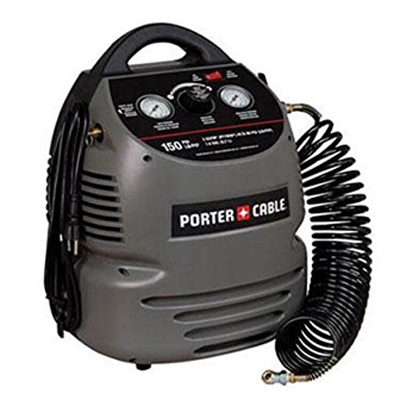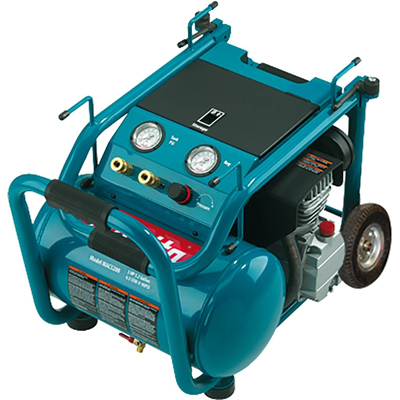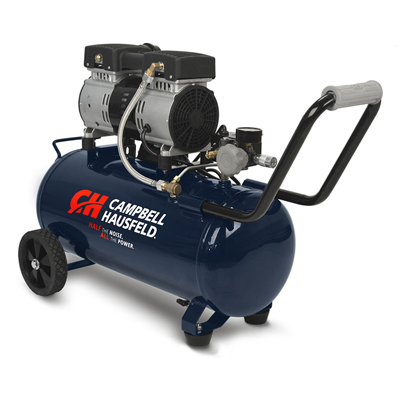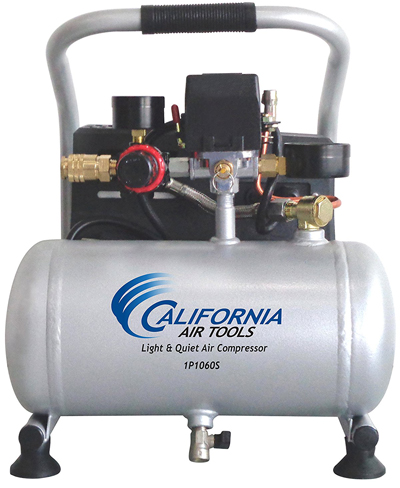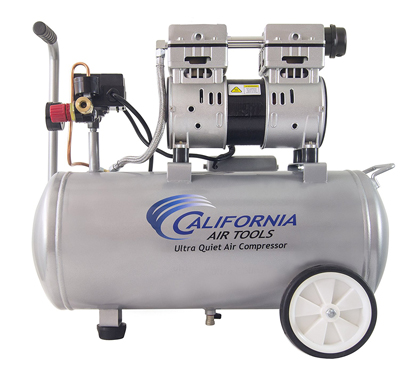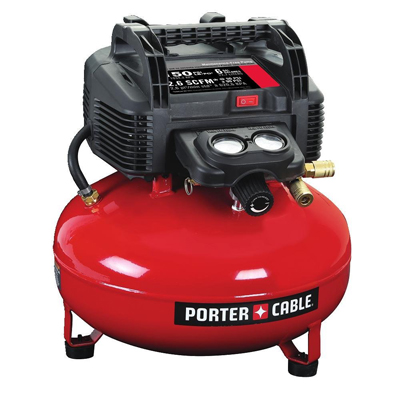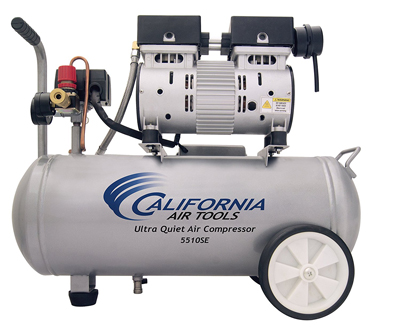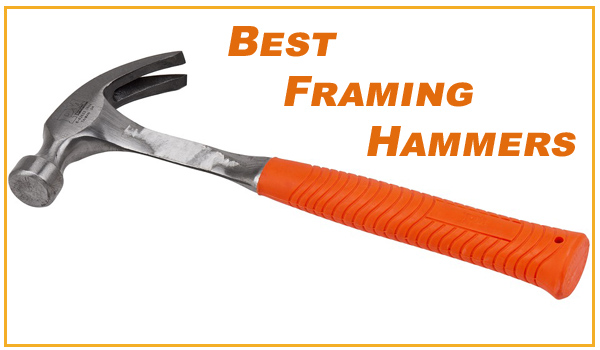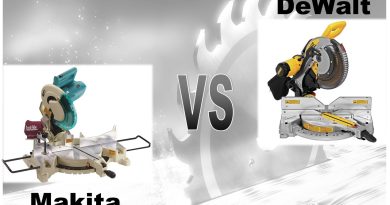Top 10 Best Air Compressors
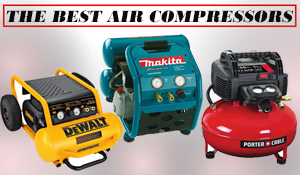
But then, shopping for the best air compressor remains a big deal and that’s why I decided to write a review of the top 10 best air compressors in 2020.
We sampled over 20 air compressor from different brands and compared how they performed common tasks that compressed air. After a fortnight of intensive testing, plus my experience with most of these air compressors, we finally came up with a shortlist of 10 products and here they are.
1. Porter-Cable CMB15 – Best Compressor for Inflation
Pros- Very portable
- Compact and lightweight design
- Enclosed exterior
- Low maintenance
- Quick start
- Low-quality accessories
I know a lot of people might just need a compressor for the light duties like filling tires, balls, and other inflatables. You just want a small compressor that you can carry almost anywhere, even in your trunk.
I bought this compressor in 2013 for my kids. They love bicycles and the eldest knows how to repair a puncture but I didn’t want them near my compressors.
This one is very lightweight and easy to use. The gauges are easy to read but I wish Porter Cable had included several other accessories. This model comes with a tire inflator only so for other tasks, you might need to purchase accessories. Don’t be excited about their 8-piece accessory kit; only inflation nozzles may be important.
Consider getting a few quick-connect couplings to use it in more ways other than inflation. Also, the stock accessories are of low quality. Consider buying a replacement of the hose and chuck when buying the unit.
Anyway, it is a cheap compressor considering the likes of Rolair FC1500HBP2 offer the same performance and cost more. But still, this compressor is a force to reckon. It works well with staplers, nail guns, and several other small air tools.
It packs a powerful 0.8HP motor that runs on electricity delivering a maximum of 150 psi (2.0 cfm @ 90 psi) which is great for a 20 lbs. air compressor Rolair weighs twice and the performance is in the same range. I also like its safety as all moving parts are enclosed in the unit. This also tries to reduce the noise it emits though it is still quiet than most similar compressors out there.
I know a lot of people complain that the tank is small. Yes, a 1.5 gallons tank is small but then this is a light duty air compressor. If you want something bigger, check out the likes of PowRyte Elite and PORTER-CABLE PCFP12234. In addition to this, something like Rolair has a similar tank and is much more expensive so the Porter-Cable CMB15 is just fine.
I also like its start system; very quick and no delays even in cold weather. If you also want something that won’t be stressing you regarding its maintenance, this is your tool too. The oil-free design will give you the peace of mind you require.
2. Makita MAC5200 Big Bore – Best Heavy Duty Compressor
Pros- Folding push handle
- Rugged pneumatic wheels
- Storage compartment
- Heavy duty performance
- Easy oil check
- Very heavy
- Little loud
- Very expensive
Finally, DEWALT got a competitor when it comes to the durability and build-quality of their power tools. I have used this compressor for quite some time and it is still as solid as a new one. Both aesthetically and in terms of performance, it hasn’t grown old.
It packs a 5.2-gallon tank, a powerful engine, and a strong metal frame making it among the best heavy duty compressors. Though it requires careful maintenance, it is such a workhorse that will tackle almost all the air tools you can mention; remember it delivers an incredible 6.5 CFM @90 psi.
The first thing you will notice about this Makita compressor is the unique construction It has a solid frame that stretches from the foldable handles all the way down the wheels an curves into a bumper. To ensure a sturdy and strong structure, the cylinder lies on both sides of the frame something that makes pushing very easy as the entire weight is at the furthest point. To put it in your trunk, just fold the handles and you’ll have a single block.
I also liked the rugged wheels; unlike my other compressors, these ones have gone through thick and thin but are still in great shape. I found a little trick to tag along long hoses without necessarily carrying them separately; wind the hose on the top handlebars. You can also put all your accessories in one place as Makita designed a simple storage compartment. On the downside, this compressor is very heavy but then its ruggedness and raw power justify the 100 lbs. plus.
It comes with a durable cast iron cylinder, 3 years of heavy use and in extreme weather, it has shown no signs of rust. I really applaud Makita for this considering there are many cylinders that will start rusting after a year or two.
This model boasts a 3.0HP motor that delivers up to 6.5 CFM @90 psi. This is enough raw power to handle bigger tasks even at commercial levels. But unfortunately, this compressor needs someone who can take very good care of it. If you don’t service it regularly, especially changing oil, it will give you a headache. Also, the fact that it is oil-lubricated raises concerns over oil carryovers, a common problem with most rotary compressors. But for me, I prefer these models because they cool faster and the parts last longer as long as you pamper them, that’s my secret. The glass window also helps you monitor the oil easily. But this one is a little loud and even though the engine has been firmly mounted on the frame, the vibrations are still high. Also, the fasteners come off with long use so be sure to fasten them more often.
3. Campbell Hausfeld DC080500 – Quietest Air Compressor
Pros- Quiet operation
- Easy maintenance
- 4* longer life
- Large tank capacity
- Wheeled
- Low-quality wheels
- Overheating
At times, I get jobs in institutions like schools, hospitals, and government hospitals. The work must get done fast and there should be minimal disturbance. As a businessman, I know a quiet compressor may give me another job so I choose Campbell Hausfeld, an 8-Gallon horizontal wheeled air compressor.
The Campbell Hausfeld Compressor boasts a solid low profile design and at 67 lbs. it is actually lightweight bearing in mind the likes of Makita are 100 lbs. plus. I like the tank quality as well as the handle though if you are very tall, pushing it is frustrating. I’m 6’3″ and pushing it is a punishment that’s why Makita remains a favorite when a lot of pushing is involved.
Another thing, it is not foldable like the one in Makita. In fact, it is permanent so carrying it may be quite a headache. Also, it doesn’t allow you to carry enough hose. It can do a maximum of 20ft. and when you exceed, you will be risking as it can work the regulator.
But I like the idea of mounting the engine on the cylinder. It greatly reduces the vibrations and this is one of the ways through with Campbell Hausfeld has cut down operation noise. The rubber stands on the other hand help to absorb the vibrations.
Actually, we put it together with Makita Big Bore and you couldn’t agree that the Campbell Hausfeld was indeed a 1.0 HP engine just like the rather loud Makita. In terms of performance, it still excels. Don’t think performance is compromised; it still packs some considerable power for air compressor. It can reach a peak of 125 psi and even higher. But I disagree with the manufacturer when they say it delivers 25% more air than ordinary 1.0HP compressors. This is a marketing hype; 25% more means nothing short of it being a 1.25HP compressor.
Maintenance is easy and hassle-free considering this is an oil-free air compressor. This is enough power to run two nailers and several other power tools. But then it tends to overheat on long use. This is very disappointing considering you are buying air compressor. I think this was the compromise because you can’t explain how it would have 50% lesser noise compared to other models within that budget. Also notable are the durable parts that the manufacturer claims them last 4 times longer. This isn’t true when it comes to parts; they are low quality and wouldn’t last you through three projects successfully. But the cylinders, pistons, and the rest of the major engine components durable but only when you service it regularly.
4. DeWalt D55146 – The Pro Workhorse
Pros- Easy portability
- High power output
- Extended motor and pump life
- Fast recovery
- Stand and handle
- Excellent aftersales
- Quite loud
- No hose and attachments
If you are after raw power, reliability, and durability, this is also another compressor that offers the best in class performance just like Makita Bog Bore. It packs a 1.6HP motor that delivers quite some impressive power – 200 psi. On the other hand, EHP® Efficient high-pressure technology ensures the machine runs optimally allowing the motor and pump to last longer.
One thing I like about this compressor is its portability. I won’t say its light enough to carry it from the garage to your car trunk but at least you can push it around. It weighs over 80 lbs. but at least it’s lighter than Makita which is 100 lbs. plus.
Notably, it has large 10-inch wheels that can withstand any working conditions; from oily floors to the rugged terrains. The design also incorporates a vertical stand for a smaller footprint and collapsible handles for an easy push around the working station. Above all, when handles are compressed and the unit made to stand upright, storage space is greatly reduced.
What I really like about this compressor is the performance.It delivers enough power to handle all small to medium tasks. It can do a maximum of 200 psi and has a fast recovery thanks to 5.0 SCFM @ 90 psi which ensures the tank is full again after the initial exhaustion. I have had mine for 3 years and I use it heavily but the motor and pump are still in great condition so it would be safe to say that indeed, EHP technology works.
There have been no fluctuations in power, only a slight drag when it needs servicing.
Another strength of this model is its efficient cooling system. Unlike most compressors that tend to overheat with long use, this is the real workhorse. You can comfortably do 12 hours plus without any power and performance fluctuations. But then it’s quite loud compared to something like Campbell Hausfeld DC080500. If you want to use a longer hose, this is still your product as it can be used with extension cords thanks to the consistent amp draw. But note that it does not come with the hose and attachments so you will have to budget for them when buying it. Regarding maintenance, you don’t have to worry as it comes with an oil-free pump.
5. California Air Tools CAT-1P1060S – Best Affordable Air Compressor
Pros- Very affordable
- Lightweight design
- Ultra-quiet operation
- Low maintenance
- Beads in the tank
- Loose pressure manifolds
There’s nothing much to be talked about this compressors performance. Definitely, form its price, it’s not something that can handle large commercial tasks and that’s why it is labeled a great air compressor for home use. With a 0.6HP single-stage engine that delivers up to 1.2 CFM @ 90 psi, you can count on it for the simple tasks like inflation, airbrushing, nailing, painting, and so on. I also like the oil-free pump design; you won’t have to worry about servicing and maintenance as is with oil lubricated pumps. The operation noise is very impressive. At only 56dB, it’s so far the quietest air compressor I have used.
But then Campbell Hausfeld DC080500 remains my choice for the quietest compressor because of its power – it’s a 1.0HP motor compared to this one, a 0.6HP motor.
Another thing I liked about this compressor’s performance is the recovery time. It takes only 50 seconds to fill the tank from empty to full and surprisingly, form 90 psi to 120 psi in just 15 seconds. I won’t say the 1-gallon tank is very small; I always believe in “what you get is what you pay for”. But there are claims that suggest that California Air Tools doesn’t test all the units before releasing them to the market. Though the unit we bought was okay, there seems to be a lot of units that come without proper testing. Several compressors come with very fine metal beads in the tank so it’s imperative that you check it out before using it. These beads block and damage the nozzles which also come loose after some time and this is the last thing you’d want with an air compressor; we all know that gravity of air at such high pressures. Also, though not a con, I wish it had wheels to help in portability – the unit comes with rubber feet. But fortunately, it is very lightweight; at around 30 lbs. only, carrying it should not be a major concern.
6. California Air Tools 8010 – Best Hot Dog Compressor
Pros- Lightweight design
- Oil-free
- Built for portability
- Reliable performance
- Extended life
- Poor valve material
Like earlier said, this is an 8-gallon compressor with a steel tank. I tend to compare it much with the Campbell Hausfeld DC080500 because they are both 8-gallon compressors and notably, they retail at almost the same price points, but Campbell Hausfeld is higher. But I think much of the difference comes with the design and performance. They are both 1.0 HP compressors and their SCFM and PSI is in the same range. But notably, Campbell Hausfeld has better performance; 125 Max PSI and 2.4 CFM @ 90 PSI while CAT 8010 delivers a maximum of 120 PSI and 2.20 CFM at 90 PSI.
Another interesting area I’d like us to focus on is the operation noise. You must have noticed these two brands market their compressors as “ultra-quiet” but as we know, quiet is relative. From our tests, we find California Air Tools to be a bit louder so the crown for the quietest air compressor goes to Campbell Hausfeld. We recorded an average of 66 dB in this air compressor but the manufacturer puts it at 60 dB. Regarding the engine, this is still a two-stage oil-free compressor so maintenance is less intensive. Just like Campbell Hausfeld, Makita, DeWalt and the rest of the top brands, CAT also tried to improve the durability of the major components.
The motor does 1680 RPM which greatly extends its life cycle. Remember, the higher the RPM, the higher the wear and tear. When it comes to design, this compressor has a single-handed handle and wheels that make pushing it an easy task. I like the wheels build quality, far much better than what is in Campbell Hausfeld. It is also lighter; it weighs around 54 lbs. and considering it’s an 8-gallon, this is really nice. My only problem is the pressure valve material. It’s very poor and will break if not used carefully.
7. Makita MAC700 Big Bore – Solid, and Reliable Performance
Pros- Fully enclosed engine
- Fast recovery
- Highly versatile
- Rugged design
- Easy drain valve
- Quite heavy
- Low ground clearance
This is another air compressor in the Makita Big Bore Series and just like the rest, it’s fully loaded when it comes to power and performance.
The first thing you will notice about the Makita Big Bore is the fully enclosed body. I really like this approach as it covers all the moving parts of the engine; you know how dangerous they can be. Besides the safety, it at least reduces the operation noise now that all the sound is trapped inside. But I’m not saying it has low noise operation that can match the likes of Campbell Hausfeld. But for a 2.0 HP engine, 80 dB is not that bad; remember, raw power is your main goal.
If you are the type that dreads oil lubricated compressors, this one is not for you. This one has an oil-lubricated pump that requires keen maintenance and servicing. But then its power is something you can rely on. You can run it for hours without it overheating, something that is common in oil-free compressors.
If you want something that will offer consistent airflow for hours, this is one compressor you should consider narrowing down on. It packs a 2.0HP engine capable of powering the common air tools; Sanders, staplers, nailers, you name them.
If you require up to 3.3 CFM, this is your compressor. It has been rated as 130 PSI Max. and 3.3 CFM @ 90 PSI, ratings it clearly cements considering its performance. Recovery time is very short and will be ready for another round of work in just a few seconds.
But my problem with this compressor is its portability. Yes, it’s a small 2.6-gallon compressor but 52 lbs. is quite heavy to carry around. At least if it had wheels, it would be easier to move it around but fortunately, the handle covers for this.
Another thing, I wish Makita had raised the clearance a little bit. There’s very little space remaining between a flat ground and the tank cylinder. On an uneven surface, the tank’s belly gets scratched. This is the last thing you’d want on your tank. When moisture reaches the bare metal, that’s rust.
8. Porter-Cable C2002 – Best Affordable Pancake Compressor
Pros- Very affordable
- Lightweight designs
- Smaller footprint
- Low amp motor
- Minimal maintenance
- Low-quality parts
- Quite loud
The good thing with pancake compressors is that they have very small footprints thus require a very small space; whether working space or storage.
Personally, I was not a fan of pancake compressors but this one is now on my wish list. If you have very limited space, I would really recommend this compressor over hot dog or twin stack. Actually, what makes it space-saving is the vertical tank approach as opposed to horizontal.
The capacity is not compromised at all; it’s a 6 gallon and a good hot dog we can compare it to is the California Air Tools 5510SE that has a 5.5 gallons tank.
Regarding performance, this little workhorse comes with a powerful 1.0HP electric powered motor. Something worth mentioning here is the low amp motor that ensures efficiency and most importantly, guarantees quick starting during cold weather. The C2002 has a maximum pressure of 150 PSI so refills don’t take forever. Capable of delivering a steady 2.6 SCFM @ 90 PSI, you can trust this compressor for small tasks like painting, nailing, inflation, and other similar tasks.
You also don’t have to worry about servicing, this is an oil-free compressor. On the downside, I am right to say that even though the tank build and construction is fine, the regulator and valves are not heavy duty. The unit we are using to test already has a crack on one of the gauges while the nozzles look very frail so you need to be very careful.
Another thing, I find it quite loud than what I expected. Over 80 dB is quite noisy for a 1.0HP engine.
9. Makita MAC2400 – Best Value for Money
Pros- Small footprint
- Easy to move around
- Incredible power
- Two pressure outlets
- Fast recovery
- Quite expensive
- Heavy
My money value air compressor today goes to the Makita MAC2400 Big Bore.
One thing you can never go wrong with Makita is performance and they excelled here too.
The Makita MAC2400 boasts a 2.5HP motor that almost rivals the 3.0HP motor in the Big Bore MAC5200. It delivers 4.2 CFM @ 90 PSI which is enough power to handle almost all the air tools a DIY enthusiast or even a professional would use. I have used mine with sanders, nail guns, riveters, spray gun, painting and so on.
As long as you keep giving it some good pampering, it is a compressor you will rely on for years. Also, the fact that it’s oil-lubricated makes it a great choice if you are looking for a compressor that can work with air tools that need continuous airflow. I’m saying this because oil-free models like Campbell Hausfeld DC080500 and others are known for overheating. If you hate changing oil, here’s a good reason to smile. There’s a clear window for checking the oil level.
This model also comes with two pressure outlets to enable you to use two air tools at the same time without having to change the tools.
Now, when it comes to design, I like the idea of a twin-stack that greatly reduces the footprint and increases the tank volume, actually to 4.6 gallons. The body frame is also worth mentioning; a solid roll-cage construction that helps keep all the parts intact. But then I wish it had wheels and even a pushing handle like the bigger version, MAC5200 which has collapsible handles and pneumatic wheels. But the good thing is that there’s a carrying handle.
10. California Air Tools 5510SE – Ultra Quiet Operation
Pros- Large tank for the money
- Fast recovery
- Ultra-quiet operation
- Improved portability
- Easy drain valve
- Slow gauge response
- Poor valve material
And finally, here is our last product on the list, the CAT 5510SE, 5.5 gallons oil-free compressor that delivers enough power to run small pneumatic tools not requiring more than 2.2 CFM.
The first thing you would like about this air compressor is the tank capacity. 5.5 gallons is not bad for so compressor.
Even though a large tank does not translate to performance, at least you will work with minimal interruptions. Besides the large capacity tank, the drain valve’s position makes draining such an easy task. You don’t have to bend them in funny positions, a common hassle most compressor owners face.
If you decide this is the compressor you are buying, make sure your tools don’t require more than 2.2 SCFM.
The best thing about this compressor is the ultra-quiet operation. You can be using it in one room and the people in the next can hardly hear the sound. But I think this should not be a big deal to spend the day discussing as it also has low performance. We wouldn’t expect a 2.2 SCFM compressor to be making a lot of noise anyway.
One thing I didn’t like about this compressor is its inaccuracy. There are times the gauges don’t respond to the settings immediately. You may adjust the pressure and fire a few times before the new setting is picked. This can be dangerous with inflatables. You might think the psi is not enough only to over-inflate them when the adjustments are made. I also hope CAT improves their valves; they are very fragile and without care, it’s very easy to break.
Buying Guide – All You Need to Know when Buying Air Compressors
For starters, we understand that it may be hard for to shop for the best air compressors. That’s why we have this segment that has loads of information about air compressors.
If you are still not sure what compressor fits your needs, it will help you make the right decision.
Types of Air compressors
Air compressors can be classified into several categories based on a number of factors.
Classification by capacity
The first filter you will use when shopping for air compressors is the capacity.
Most pancake and single-stage models like Porter-Cable C2002 are consumer grade. If you are a DIY enthusiast, this might be an area you’d want to focus on especially with regards to value. There’s no need of spending on a professional grade air compressor for the small tasks that a consumer grade offers; remember the price is almost double.
If you run an auto shop, a wood shop, or any other professional service that requires an air compressor, you need a professional air compressor.
Most of the models you will get here are two-stage reciprocating or even rotary-screw models. There are also some ceiling models in this category that are more advanced and may even run several air tools but not simultaneously; intermittently.
Lastly, we have industrial air compressors and these are very large, and highly customized installations. As the name suggests, they are used at industrial scales for example in cooling plants, manufacturing companies, large farms, and so on.
Classification by Displacement
Positive displacement
As the name suggests, positive displacement works by forcing air into a chamber where its volume is decreased, thus increasing its pressure.
These compressors are the most common and can be classified into four groups.
1. Reciprocating compressors
Also known as piston compressors, these air compressors work in the same principles as a combustion engine but in a reverse manner. They come with pistons, piston cylinders, valves, crankshafts and the main block. Reciprocating compressors employ positive displacement and are available in a range of horse powers; from low to very high HP. These compressors are the most common in the market, a good example is Quincy QT-54.
- Simple design
- Very affordable
- Easy to install
- No oil carryover
- Offers a range of HP
- High maintenance costs
- May require foundations
- Heavy vibrations
- Many moving parts
2. Rotary screw compressors
It works on the principle of air filling the void between two helical mated screws. As the screws are turned, the air volume reduces and its pressure increases. That’s it! These compressors also use positive displacement. Oil is injected into the compression chamber and on bearings.
- Simple design
- Lesser moving parts
- Reduced vibrations
- Easy installation
- Oil-free designs are expensive
- Low efficiency in single-stage models
- Needs a clean environment
- Shorter life expectancy
- Oil carryovers in oil lubricated models
3. Rotary vane compressors
This approach uses a pump system with a stator and an 8-blade rotor. The blades are arranged eccentrically in the stator forming a crescent, swept chamber between the ports. When the rotor makes revolutions, the air is compressed. These models use oil for lubrication and cooling just like rotary screw compressors.
- Durable airend
- Field-serviceable airend
- Low rotational speeds
- Rugged design
- No oil-free designs
- Strain at high pressures above 200 psi
- Oil carryovers
Dynamic displacement
These compressors use highly rotational components that create kinetic energy which is then converted to pressure. Good examples are centrifugal and axial compressors.
Centrifugal compressors
These ones use high-speed rotating impellers to accelerate airspeed and again, a diffuser to decelerate the air thus increasing its pressure. Note that centrifugal compressors don’t use displacement.
- Highly efficient
- Delivers high psi, up to 1200 psi
- High initial and maintenance costs
- Heavy vibrations
Single-stage vs. two stage pumps
In the market, you will find single-stage and two-stage compressors. They are quite different in operation and suitability so it’s important to know what you are buying.
In single-stage, the piston’s work is to compress and deliver air to the storage tank. On the other hand, in two-stage compressors, there’s an extra piston that repeats the drill thus compressing the air almost twice. Most domestic compressors are single-stage. These are compressors that deliver up to 150 psi, anything higher than that will be two-stage.
Electric vs. gas compressors
Just like a lot of similar equipment, you get two power options with air compressors. We have gas operated compressors like Industrial Air Contractor CTA5090412 and electric powered models like Briggs & Stratton 3-Gallon Quiet Power.
Each of the two types has advantages and disadvantages.
The electric models are easy to run and operate on low noise compared to gas models. On the other hand, gas models can be used anywhere; you don’t need electricity supply. On the downside, they are very noisy.
Stationary vs. portable compressors
Stationary compressors, as the name suggests can’t be moved easily because of their size. They have very large, tanks to facilitate uninterrupted use. These compressors are normally used for heavy commercial purposes, like in a commercial garage, you are likely to find them.
On the other hand, portable compressors are much smaller and often have features that make them portable. Besides the compact designs, you may find wheels, and carry handles, in some models. These air compressors are the most popular because they cover domestic and commercial categories while stationary compressors are mainly for industrial use.
Portable compressors can be further categorized into four other groups based on the design of the tanks. We have pancake, hotdog, twin-stack, and wheelbarrow.
Pancake compressors
These come with oval-shaped tanks at the bottom and the engine and meters on top of it. Notably, they lack wheels but come with rubber feet to reduce damage on floors as well as vibrations. But then they are normally lightweight so portability shouldn’t be a major concern. Besides, they take much less space whether it’s at the working site or storage room.
Some of the popular pancake compressors include; Campbell Hausfeld FP2028, Porter-Cable C2002, Bostitch BTFP02012, DEWALT DWFP55126 and Hitachi KNT50AB.
Hot dog compressors
They are the most common compressors out there and come in a horizontal design. Also notably, there’s only one cylinder that follows the horizontal design too. Note that, even though the common ones are horizontal, we have some like DeWalt D55146 that have vertical stands so, in as much as they are horizontal, they can also be positioned vertically. They may also be wheeled or not wheeled.
Examples of the best hot dog compressors include Makita MAC700 Big Bore, Campbell Hausfeld DC080500, Senco PC1010, among others.
Twin-stack compressors
As the name suggests, these compressors stack up two cylinders, one on top of the other. Remember, the second cylinder is put on top of the other to reduce the footprint size. Here, these compressors are not wheeled; instead, they have rubber feet.
Popular models include; DeWalt D55146, Hitachi EC99S, Makita MAC2400, Ingersoll Rand P1IU-A9, Campbell Hausfeld DC040500, and so on.
Wheelbarrow
Lastly, we have wheelbarrow compressors and these are very similar to twin-stack and hot dog compressors. The big difference comes with the handles and wheels. While twin-stack compressors just have rubber feet, these ones may have wheels. The cylinders also may not be horizontal but one thing is for sure, there are handles for pushing it just like wheelbarrows as we know them.
Common examples include; Puma Air Compressors PUK-5508G, DeWalt DXCMTB5590856, Ingersoll Rand SS3J2-WB, e.t.c.
Air Compressor Glossary: Definition of Terms
For starters, the different jargon you will hear can confuse you. But here’s a definitive guide to all the common heavy terms you will meet.
PSI – This is a common one and is the abbreviation of pounds per square inch. Basically, this refers to the amount of air pressure that your compressor delivers. I the market, you will get air compressors ranging from 50PSI to 1000 PSI plus.
HP – Horsepower is also a common term synonymous with engines. Just like in cars and other machinery, it refers to the amount of power it can generate. Most standard compressors range from 1.5HP to 6.5HP but there are some that may even go up to 10HP. Remember, horsepower directly affects PSI; the higher the HP, the higher the PSI.
Brake horsepower – This is the exact horsepower input that an air compressor requires
Theoretical horsepower. This is the HP that’s required to adiabatically compress the air delivered through a specific pressure range assuming there’s no energy loss at all. Actually, this is often assumed and it may be hard to achieve such performance.
CFM – Abbreviation for Cubic Feet per Minute, this refers to the total air volume an air compressor delivers. PSI directly affects CFM and you will find it denoted as 3CFM @ 90 psi.
SCFM – This is the acronym for Standard Cubic Feet per Minute and refers to the CFM of the compressor under standard conditions. But this should not worry you much because standard conditions are relative.
Compressor efficiency – This refers to the ration of the theoretical HP to the brake HP
Inlet & discharge pressure – Refers to the absolute air pressure at the suction point (inlet) and the absolute air pressure at the delivery (outlet), respectively.
Compression Ratio – This is the ration of the absolute inlet pressure and absolute discharge pressure
Kick-in pressure – A low-pressure switch factory setting for starting the compressor to allow it re-pressurize the tank
Kick-out pressure – The high-pressure switch factory setting that stops the compressor from pressurizing the tank
Factors to consider before buying an air compressor
That’s what we are going to discuss in this segment. So without further ado, here are the factors you will want to address before buying any.
Performance
This is the most important aspect when shopping for air compressor. You want to make sure that what you are buying will power all your tools as you wish. Basically, it should fit all your needs. When talking about performance, there are things involved.
SCFM – First, you will want to check the SCFM which refers to the air volume a compressor delivers.
A compressor with high SCFM is able to deliver powerful and constant airflow to your air tools. But the most important thing to note is that it directly determines which tools can be used by your compressor. Actually, I normally advise people to do a little research especially if you have more than one air tool to use. Get a compressor that serves the tool with the highest SCFM rating.
PSI – Another important thing would be PSI which stands for pounds per square inch.
This refers to how much pressure your air compressor can produce. The higher the PSI, the more air a compressor can store. This should be a top priority because you don’t want your projects delayed. For the medium range air compressor, like the ones we have reviewed, they range between 90-100 PSI though others can go up to 150 psi. This is enough pressure for powering most air tools; nailers, guns, and the rest. If you want a compressor for commercial use, get something with higher psi, say 200 psi and above.
HP – I know a lot of people are quite conversant with this.
Horsepower is the total power that your compressor’s engine delivers. This should not be confused with SFCM which refers to the total power delivered to your tools – the higher the HP, the better the compressor. Typically, air compressors range between 0.5 – 6.5HP but on average, a 2.0HP compressor should serve all your needs. When assessing HP, work with the running HP and not the peak HP as the latter may not be achievable.
Tank size – Air compressors come with either aluminum or steel tanks measured in gallons.
Definitely, with a larger tank, you can work for a longer time compared to most of these pancake compressors. The airflow is also steady and more powerful. On the other hand, small tanks are easier to carry but wouldn’t be ideal for long continuous use. But if you have to buy it, consider getting one with the highest SCFM – at least its recovery time will be shorter.
Pump Options
Another big question you should ask yourself is, what type of pump do you want? There are several options available each with its pros and cons.
Oil-lubricated pumps – To keep the moving parts running smoothly, these compressors are lubricated using oil. Even though these compressors require intensive maintenance, they are the best when it comes to raw power. Also, they can run for longer time without overheating. Personally, I like oiled compressors and they stay in top condition as long as you take good care of them.
Oil-free pumps – These compressors don’t use oil and that’s why most people like them. You don’t have to worry about maintenance at all. They are also lighter because they have less moving parts compared to oil-lubricated pumps. But then, most overheat and don’t stay for very long.
Single-stage pumps – These compressors only have one piston and are synonymous with light-duty compressors. If you want a compressor for these light duties like painting and nailing, get a compressor with a single-stage pump.
Two-stage pump – As the name suggests, there are two phases in two-stage compressors. The process of compressing air is basically repeated. If you want more power, look for a two-stage air compressor.
Power
What powers the engine?
We have gas powered and electric engines. Consider where you will be working mostly. If it’s far from electricity mains, get a gas engine. You can work with it just anywhere; no cords, no tangling. But the problem with gas engines is that they are maintenance intensive. You’ll need to change the oil, filters and other parts often.
On the other hand, electric engines are very easy to operate. You just plug it in and go; no hard starts in winter or emissions.
Operation noise
How loud is your compressor when in operation? Just any other Tom, Dick and Harry will tell you that a compressor’s sound is not a bother. But if you work with these tools daily, you understand why you need something that is almost quiet. This is why it’s important to consider the noise level of your preferred compressor.
So far so good, belt-drive systems have proven to be the best compared to direct-drive systems as they are quieter. Also, some brands fully enclose the engine to try and confine the sound inside. California Air Tools is among the brands best known for quiet engines.
Brand
There is a reason Makita and DeWalt products dominate the market; quality. This is what top brands are associated with. Even though they may be quite expensive, they offer real value for money. Typically, a brand from DeWalt, California Air Tools, Makita, Porter-Cable and the rest of the big brands will last longer and offer better performance than these cheap models.
There’s also the issue of parts and accessories. Top brands are known to have readily available parts and accessories. Nothing can be as stressful as looking for a replacement part for a little-known brand. This is because most retailers stock what the market has and not just any other brand that has not sold.
You should also consider top brands because of their after sales. You will realize that heavyweights like Makita and DeWalt have genuine warranties on their compressors and their after-sales is well established compared to some of these small brands that don’t know the value of customer service.
Accessories
It is imperative that you know what accessories come with the compressor you are about to buy. This is in light of the fact that many models come with the main unit only. This means you will have to buy hoses, couplers, nailers, blowguns and the other popular accessories.
A lot of people forget this leaving them with a sudden rise in cost for the accessories. When setting your budget, iron this out clearly to avoid straining your pockets.
Common air compressor applications
Air compressors are very common not only in garages but at home too.
They have a very wide application and here are some of them.
Nail/staple gun – These hand tools come in very handy in speeding construction work. While using a hammer is tedious and slow, nail and staple guns can nail up to 60 nails a minute. What they do, the high pressure drives the nail into the wood, concrete or steel.
Airbrushing – There are those cleaning needs that just need air blown on the dirty surface at very high pressure. This is what air compressors can do too. An air blower is what’s commonly used for this task and has moderate pressure compared to what you find in other tools. Actually, one of the safety tips of using air compressors is to use the right tool for the right job. A lot of people use any power tool for airbrushing which may turn out to be catastrophic.
Sandblasting – This is another common use of compressors which uses sand and air at high pressure to refine surfaces. It can remove rust, paint and any other undesirable imperfection.
Sanding – Air sanders are preferred to electric sanders because they don’t overheat and the pressure they offer is the best for the realization of a smooth surface.
Pressure washer – These tools wash out dirt by spraying water at very high pressures on the dirty surfaces. This is another dangerous application of compressed air. When working, don’t point the water jet on people, walls, and other surfaces. Also, don’t use it when on a ladder as the pressure may throw you off balance.
Inflation – Most of the basic air compressors are inflators and come in handy when inflating a tire, ball, inflatable sofas and so on.
Diving – To reduce the amount of air that divers require, compressed air is used. Once compressed, divers can go down with a small tank but with enough oxygen to last them for long.
Airbrush painting – This has proved to be the best painting especially to those in creative art. It produces even coats and applies more paint where it is required.
Paintballing – Have you ever gone for paintballing? If not, this is one sport that gives you a real combat experience and guess what, some of the paintball guns use small air compressors.
Air baloons – I’m sure you are aware that some air balloons are powered by air compressors. Air is compressed into a small volume to reduce the carry load.
Helpful buying tips
Now that you know how essential an air compressor can get, here are a few helpful tips to help you when shopping.
- Avoid cheap brands; they are built using low-quality materials and often break down after a short time
- Look out for extras like low oil shutdown, and thermal load shutdown for your machines safety
- Always check the SFCM of your tools and that of your preferred machine
- Buy a compressor with high power output in case you upgrade your tools
- Insist on something with a longer warranty
Air compressor safety tips
I know a lot of people disregard air compressor safety. Many are times you will see kids playing with this equipment.
Remember, this is not your ordinary air; this is pressurized air that can run nails in rocks!
So, to be on the safe side always, these are the dos and don’ts.
- Read the manual and familiarize your safe with the parts before engaging in any serious work
- Always know the safety features like kill switches and shut-off valves in case of emergencies
- Don’t use compressed air in place of vacuuming
- Don’t use indoor compressors outdoors and vice versa
- Use your compressor in a well-ventilated area
- Don’t breath in any fumes from the compressor
- Replace the compressor when it gets rust. Such tanks are more likely to explode
- Never alter or try to bypass relief valves
- Never do gas refills when it is running
- Change the oil when the compressor has stayed idle for some time
- Avoid tangling the hoses with any clutter
- Never allow children around the air compressor whether it is running or not
Air compressor maintenance tips
I see a lot of people asking, how long do air compressors last? I find this an interesting question because there is more to it than the basics. For most guys, a durable air compressor must be from a top brand, with a heavy-duty build, and with a warranty of course for reassurance.
What people don’t know is that the wear and tear and maintenance also matters. A compressor used daily will have a shorter lifetime than one used once weekly. If you want your air compressor to give you good service, always adhere to these maintenance practices.
Use it for the right job
A lot of people end up with damaged compressor just because they used it on the wrong job.
Fasten it often
Because of the intense and heavy vibrations, most fasteners tend to unwind and start coming off.
Monitor hoses
This is also important because the hoses when damaged or worn out, they may overwhelm the compressor. Remember, when you want a certain pressure and some is lost because of leakage, the compressor might want to compensate for the loss thus stressing it.
Schedule servicing
If you have an oil-lubricated compressor, change the oil regularly, at least monthly. Also, use the recommended oil type and not the motor vehicle oil that remained during your car’s last service.
Other important parts you need to replace from time to time include filters, heat exchangers, a separator element, among others. You must get all this information in the user manual.
Clean the parts regularly
Frequently Asked Questions
1. How often should I change oil in my air compressor?
If you’d like an easier maintenance, better choose oil-free models like Campbell Hausfeld DC080500.
2. Reciprocating or rotary screw compressor: which type of air compressors to choose?
However, if your compressor is supposed to face industrial work volumes, we would recommend more durable, energy efficient, and heat resistant rotary screw compressors.
3. Are air compressors heavy? Are there compact models?
4. How long do air compressors last?
Final Words
Compressed air has very many applications and you will probably need it for your DIY tasks.

